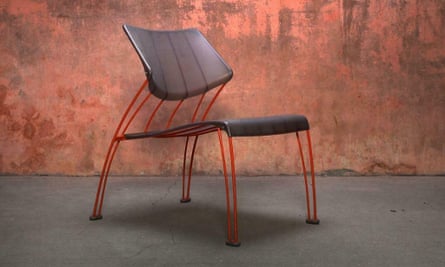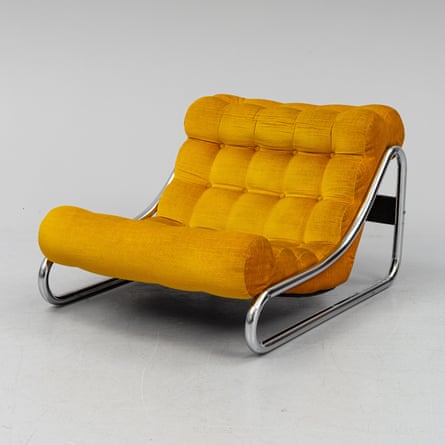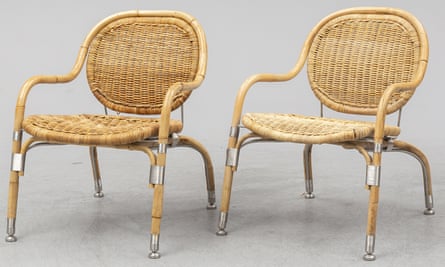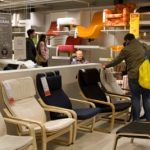Flat pack, rising prices: Ikea furniture is now collectable
Don’t chuck out your old flatpack furniture just yet – you could be sitting on a fortune. Since Ikea launched a scheme to buy back and resell unwanted furniture in November, classic designs once sold at bargain prices by the retailer have become expensive must-have items. Some collectors are willing to pay thousands of pounds for vintage pieces designed for the Swedish chain, including some that were common in stores as recently as the 1990s.
A set of four Vilbert chairs, a multicoloured MDF and melamine product sold by Ikea in the early 1990s for about £60, are on sale at Pamono, a vintage and contemporary furniture website, for more than £4,500.
The Vilbert chairs had just a small production run so are unlikely to be hanging around many British homes today. But even some basic Ikea furniture that had huge production runs can fetch significantly more than they cost originally.
Jarpen metal wire chairs that sold for as little as £12 in 1986 now go for £300 or more, while the stackable Hasslo polyurethane chairs for indoor and outdoor use, popular in the 1990s, now have asking prices of £675 for four.
“The most popular vintage Ikea pieces are from the 1980s and 1990s,” says Wava Carpenter of Pamono. “I think this is because Ikea in this era began to define itself as a brand aimed at a youthful, urban and contemporary audience. The silhouettes are fun, eye-catching and colourful, even while maintaining a rather minimalist quality.”
 View image in fullscreenHasslo chairs by Monika Mulder cost £600 for four at Pamono. Photograph: Pamono & 1st Modern
View image in fullscreenHasslo chairs by Monika Mulder cost £600 for four at Pamono. Photograph: Pamono & 1st Modern
Ikea’s Buy Back initiative, which allows customers to hand back used or unwanted pieces, was launched in stores across the UK and Ireland last month. Participants will receive vouchers to spend in store, with their value calculated according to the condition of the returned items, which will then be put back on sale in the store or recycled.
Ikea did not arrive in the UK until 1987, when it opened a store in Warrington. The furniture it sold elsewhere during the 1960s and 1970s borrowed heavily from Danish midcentury modern trends that are now popular globally.
Gillis Lundgren, who designed the Billy bookcase and is credited with inspiring the flatpack furniture revolution, was behind many early Ikea creations regarded as modern classics, fetching north of £6,000 each.
His 1972 Impala chair, with a tubular steel frame and vibrant red or gold upholstery, is currently on sale through 1stDibs, a New York-based high-end furniture website for £6,210.
 View image in fullscreenGillis Lundgren’s Impala chair is on sale for more than £6,000. Photograph: Bukowskis
View image in fullscreenGillis Lundgren’s Impala chair is on sale for more than £6,000. Photograph: Bukowskis
“There’s a rising market for 1960s Ikea furniture, which often looked like midcentury modern Scandinavia,” says Carpenter. “It’s a bit less distinctive in terms of the brand identity, but it’s also pretty rare to find these days.”
Some Ikea designs that fetch £750 or more at auction have been reproduced for modern buyers at a fraction of the price. The Lovet leaf-shaped side table was Ikea’s first flatpack product, released in Sweden in 1956. At 1stDibs, an original is for sale at £720, but it has been reproduced by Ikea as the Lovbacken table and is still on sale in stores, priced at £45 in the UK.
In Ikea lore, the Lovet table inspired the flatpack system after Lundgren was forced to saw the legs off to fit it into his car.
While Ikea may be regarded by some as cheap and utilitarian, in Stockholm, Eva Seeman, head of modern works of art and design at auctioneers Bukowskis, says many items have stood the test of time.
“Some of Ikea’s earlier pieces are really quite good quality both when looking at the actual make as well as the design as being very up to date from the period it was designed in,” she says. “The other reason [they are popular] is that they are still a lot more affordable for a larger group of people than for instance Danish equivalents, which the designers at Ikea were very inspired by (to say the least).”
 View image in fullscreenHarold Fust Singoalla’s daybed for Ikea reached £3,600 in an auction at Bukowskis. Photograph: Bukowskis
View image in fullscreenHarold Fust Singoalla’s daybed for Ikea reached £3,600 in an auction at Bukowskis. Photograph: Bukowskis
At Bukowskis, the highest under-the-hammer price fetched for an Ikea item was £3,600 for a 1960s daybed, Singoalla.
Your best bet that you are sitting on a flatpack financial surprise is if it was made under the PS series. PS stands for Post Scriptum, a collection introduced by Ikea in 1992 and repeated about every three years to complement its standard range of products.
 View image in fullscreenMats Theselius’ PS series chairs for Ikea sell for about £300 at auction. Photograph: Bukowskis
View image in fullscreenMats Theselius’ PS series chairs for Ikea sell for about £300 at auction. Photograph: Bukowskis
Seeman adds: “The small editions Ikea made in what was called the PS series are generally attractive. One example is the chairs by Mats Theselius.” These tend to go under the hammer for about £350.
Given that the vast majority of Ikea furniture was meant for everyday use, few items remain in pristine condition. The Amiral armchair, designed by Karin Mobring for Ikea in the 1970s, features an Ikea signature chrome metal frame with a thick saddle leather seat and backrest. Bukowskis sold a worn, marked and stained pair for about £500 last year, but 1stDibs is seeking about £4,000 for a pair in perfect condition.
So could your old Billy bookcase one day be worth something? No, is the short answer. More than 110m have been made since 1978, and the store still sells about 4.5m of them every year. It is unlikely ever to enjoy rarity value.




